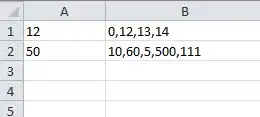The way I would go about it would be to start by breaking up the problem into a bunch of columns, each with a piece of the problem. For example:
A B C D E F G H I J K L M N
1 12 0,12,13,14 2 5 8 0 12 13 14 Yes Yes No No Yes, Yes, No, No
2 101 101,102,103,104 4 8 12 101 102 103 104 Yes No No No Yes, No, No, No
These are the expressions for C1 through N1:
C1 =FIND(",",B1) D1 =FIND(",",B1,C1+1) E1 =FIND(",",B1,D1+1)
F1 =LEFT(B1,C1-1)+0 G1 =MID(B1,C1+1,D1-C1-1)+0
H1 =MID(B1,D1+1,E1-D1-1)+0 I1 =RIGHT(B1,LEN(B1)-E1)+0
J1 =IF(F1<=$A1,"Yes","No") K1, L1, M1 (copy from J1)
N1 =J1&", "&K1&", "&L1&", "&M1
If case it's not obvious, the "+0" is a handy way to force a text value into a number, so that the comparisons in I, J, K, and L are done as numeric comparisons rather than as text.
For C2 through N2, copy from C1 through N1.
If you don't want to use extra columns, you can join the results from the multi-column version into one giant, complicated expression in a single column. It's easier to do that in several steps. For example, the first step would be to combine the FIND expressions with the string expressions. Here's some code for that:
F =LEFT(B1,FIND(",",B1)-1)+0
G =MID(B1,FIND(",",B1)+1,FIND(",",B1,FIND(",",B1)+1)-FIND(",",B1)-1)+0
H =MID(B1,FIND(",",B1,FIND(",",B1)+1)+1,FIND(",",B1,FIND(",",B1,FIND(",",B1)+1)+1)-FIND(",",B1,FIND(",",B1)+1)-1)+0
I =RIGHT(B1,LEN(B1)-FIND(",",B1,FIND(",",B1,FIND(",",B1)+1)+1))+0
Those are pretty hideous, because the uses of E uses D, which uses C, and those are used several times by G, H, and I. Putting all the intermediate results into hidden columns saves a lot of duplicated expressions.
Things get worse if you want to go beyond four comma-separated number in column B, but the way to add columns should be pretty obvious.
Allowing B to have a variable number of comma-separated numbers is not so obvious. The trick is to add some IF statements, testing for error conditions. That raises one final point, that this doesn't include any error checking other than what's built into Excel. A robust spreadsheet should include at least some error checking.

